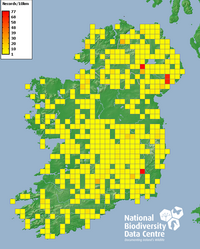Species Wood mouse

Facts about the wood mouse
- English/Irish name: Wood mouse/ Luch féir
- Scientific name: Apodemus sylvaticus
- Number of young: Between 2-11, born between March and October.
- Diet: Seeds, fruits, buds and invertebrates.
- Habitat: Habitats rich in ground cover, including deciduous woodlands, hedgerows and grasslands.
- Photos: Banner photo and Photo (R) ©John Robinson

Identification
Female |
Male |
|---|---|
| Length 10 cm; Tail length 10 cm; Weight 17–27g | Length 10 cm; Tail length 10 cm; Weight 17–27g |
- Large black eyes and almost hairless ears
- Pointed nose and long whiskers
- Long, slender tail, sometimes with a white tip
- Orange-brown fur on the back and sides with white belly fur
Photo: ©John Robinson

History of the wood mouse in Ireland
The wood mouse, also known as the long-tailed field mouse, is the only small rodent in Ireland with scientific evidence confirming its long-term presence on the island. Radiocarbon dating indicates it has been in Ireland since the Mesolithic period, likely arriving with early humans around 10,000 years ago, like many of the country's other mammal species.
Its Irish name ‘Luch fhéir’ is linked to its common name, which means ‘grass’ or ‘field’ mouse.
Photo: ©Kevin McCann

Distribution and status
The wood mouse is likely present throughout rural Ireland, except for highly degraded areas of bog land and the highest mountains. Many offshore islands and islands on freshwater lakes and loughs also have wood mouse populations.
Further afield, the wood mouse is widely distributed throughout Europe but does not extend far into the coniferous zone, being absent from most of Scandinavia.

The wood mouse has brown upper body fur and a white underbelly (the house mouse is more of a greyish brown).
It can also be distinguished from other small rodents by its large eyes and ears and long hind feet. They have a long, slender tail, which gives rise to their other common name — the long-tailed field mouse.
The wood mouse is highly adaptable and found in most habitats. As its common name suggests, it is a woodland specialist but can also be found in hedgerows, agricultural land, and grasslands, preferring habitats rich in ground cover. It tends to be scarcer in wetter habitats and at higher altitudes, and unlike the house mouse, it has a limited presence in urban areas.
The species is nocturnal and spends most of the day in a burrow. Live trapping yields many wood mice at first light, with infrequent captures during daylight trapping hours.
Individual home ranges are initially small but increase drastically during the breeding season. Males can increase the size of their home range by up to five times (from approximately 2000m2 up to 10,000m2 in deciduous woodland), while female ranges increase much less. Females retain exclusive territories, while males can overlap territories of several individuals.
The wood mouse is an opportunist feeder, consuming both plant and animal foods. Its diet varies based on habitat, season, age, and sex.
Studies show that juveniles in woodland environments consume fewer seeds than adults, while females eat less animal matter than males during spring and summer.
In colder months, the wood mouse primarily depends on seeds and plant material, whereas insects become a key food source in warmer seasons. It may also prey on larger animals, such as frogs. Its diverse diet and foraging habits make it an important seed disperser.
Breeding tends to occur between March and October. Litter sizes peak between June and August, with females producing up to six litters per season in the most favourable conditions.
Females experience oestrus for less than four hours but mate with multiple males. Pregnancy lasts approximately three weeks, and litters typically contain four to seven young, though they can range from two to eleven. DNA analysis has confirmed that a single litter of wood mice can have up to four different fathers.
At birth, the young weigh 1–2g and usually leave the nest within three weeks. They can begin breeding within their first year.
The impacts of recently introduced small mammals, such as the bank vole and greater white-toothed shrew, on the wood mouse remains unclear.
While the wood mouse and bank vole appear to coexist without significant negative effects, evidence suggests that the presence of both invasive species together may be contributing to a notable decline in wood mouse populations.
The wood mouse is not protected in Ireland.
